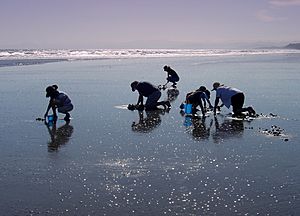Tuatua facts for kids
Quick facts for kids Tuatua |
|
|---|---|
| Scientific classification | |
| Synonyms | |
|
The Paphies subtriangulata is a type of clam that you can eat. It's known as tuatua in the Māori language. This clam is part of a group called Mesodesmatidae. It is only found in New Zealand.
You can find tuatua clams buried in clean, fine sand on ocean beaches. They live on all three main islands of New Zealand.

The tuatua has a large shell that isn't perfectly even on both sides. Its hinge, where the two shells join, is on one side. The pipi (Paphies australis), which is a close relative, has a shell that looks the same on both sides.
People enjoy eating the soft parts of the tuatua clam. They are often made into fritters or boiled and served right in their shells. For a very long time, the Māori have used tuatua as a food source. Their shells are often found in old Māori rubbish piles, called middens.
Tuatua clams can dig into the sand very quickly. This makes them a bit tricky to catch! They also squirt water when they feel threatened. There are special rules about how many tuatua you can collect. In some places, one person can only collect between 50 and 150 tuatua clams per day.
Contents
Different Kinds of Tuatua
Scientists have found three main types of tuatua. They are called subspecies.
Common Tuatua (Paphies subtriangulata subtriangulata)
This type of tuatua is found all over the North and South Islands of New Zealand. It can grow up to 76 millimeters (about 3 inches) long. Its height can be up to 48 millimeters, and it can be 28 millimeters thick.
Chatham Islands Tuatua (Paphies subtriangulata porrecta)
This kind of tuatua lives only on the Chatham Islands. It was named by John Marwick in 1928. This type can be a bit bigger than the common tuatua, growing up to 93 millimeters long and 57 millimeters high.
Thick Tuatua (Paphies subtriangulata quoyii)
You can find this tuatua throughout the North and South Islands, just like the common tuatua. It was named by Gérard Paul Deshayes in 1832. This type is thicker compared to its length. It can be up to 86 millimeters long, 65 millimeters high, and 38 millimeters thick.

